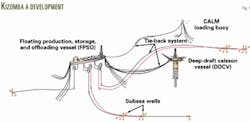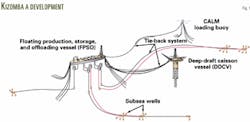The $3 billion Kizomba A project, off Angola, involves a complex production system that includes a deep-draft caisson vessel (DDCV), and subsea completed injection wells tied back to a floating production, storage, and offloading (FPSO) vessel (Fig. 1).
Esso Explora tion Angola (Block 15) Ltd., a subsidiary of Exxon Mobil Corp., is the operator of the project from which it expects to recover 1 billion bbl of oil.
This is the first of several developments planned by Esso off Angola.
Esso holds interest in nine Angola deepwater blocks, covering 11 million acres, and it estimates that recovery from the 22 announced discoveries made in these blocks, to date, might reach 7.5 billion boe.
Block 15 discoveries
Ten discoveries have been made in Block 15, in 600-1,500 m water depths. The ten are Marimba, Hungo, Chocalho, Xikomba, Kissanje, Dikanza, Mondo, Saxi, Batuque, and M'bulumbumba.
Four discoveries, announced in 1998, Hungo, Chocalho, Kissanje and Dikanza, form the Kizomba complex.
The Kizomba A project will develop the Hungo and Chocalho fields, in 3,300-4,200 ft water depth. A second, similar development, Kizomba B, will follow and produce the nearby Kissanje and Dikanza discoveries.
Besides Esso with a 40% interest, other participants in the Block 15 production sharing contract with Sonangol, the Angola state oil company, are BP Exploration (Angola) Ltd, 26.67%, Agip Exploration Angola BV, 20%, and Statoil, 13.33%.
Development plans
The Kizomba A reservoirs are of Middle to Lower Miocene in age and consist of turbidite debris flows deposited along the upper-mid slope. The structural trap is controlled by early Aptian salt movement as well as lateral channel seals.
Oil from Kizomba A will be produced from wells completed from a DDCV that will support about 34 producing wells completed with dry trees. The dry-tree completions eliminate the need for insulated flowlines that would be required for subsea completed wells.
From the DDCV, oil will flow to what Esso says will be the world's largest FPSO vessel, with a capacity to handle 250,000 b/d and to store 2.2 million bbl of oil. The FPSO houses facilities for production processing, water injection, and gas compression.
Esso's plans call for about 26 water injection wells, which will be completed subsea and tied directly into the FPSO. It initially plans also to inject the associated gas, pending other solutions for gas dispositions.
Offloading will be done to tankers through a catenary anchor-leg mooring (CALM) buoy.
Esso awarded a three-company consortium led by Hyundai Heavy Industries Co. Ltd. of South Korea the contract to build the FPSO. Other partners are Fluor Corp. and AMEC PLC.
Design work on the FPSO will be done by Fluor's Houston office. Fabrication of hull and topsides will occur at HHI's yard at Ulsan, South Korea.
Esso expects oil production to begin in late 2004.

